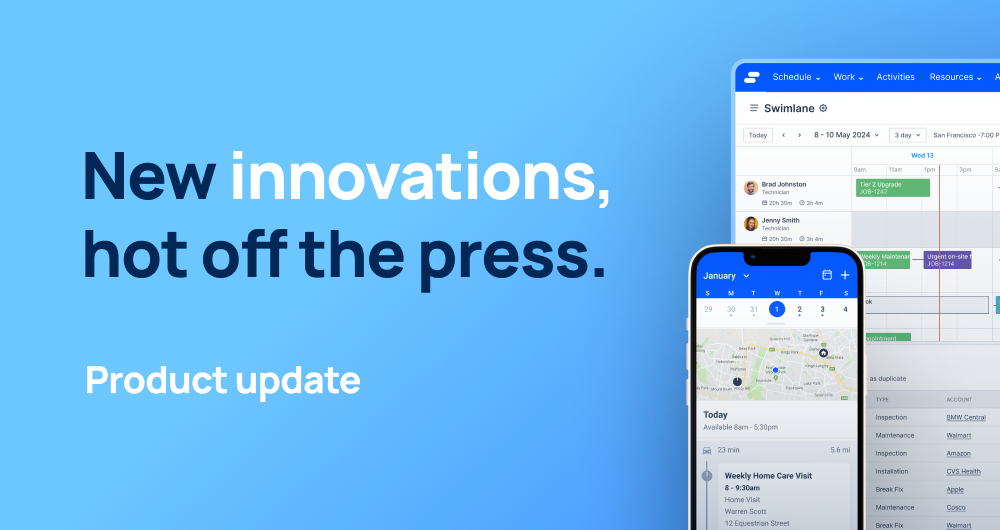How to Improve Field Service Quality: KPIs, Action Plans, and Change Management
For field service workers, business is booming. The field service market share is expected to balloon from 5 billion to 8.5 billion between 2024 and 2029.
That’s no surprise. Many sectors are relying more heavily on field service positions to address the ever-changing needs and demands of our society. Use of technologies such as solar panels and remote data centers that power cloud technology and 5G telecommunications—all of which require regular maintenance by technicians—are surging in popularity. Home healthcare needs are rising as Baby Boomers, the second largest generation behind Millennials, age into needing more medical attention and assistance; as a result, the demand for home healthcare workers has spiked. Even the number of nonprofit organizations, which typically work at various locations around their communities, has grown in recent years.
As the sectors that rely on deskless workers continue to grow, business leaders are keen to improve the quality of field service. After all, quality service and a good customer experience is directly tied to higher revenue. In this guide, we’ll walk through how to track field service with the right metrics and improve field service quality over time.
Track the quality of field service
Identify the right field service KPIs
The second step toward improving quality is choosing the field service KPIs that make the most sense for the challenges your business is facing. To get a solid sense of what those might be, take a look at customer feedback and business goals and priorities for the short- and long-term. The best KPIs will be relevant to both categories, but there will likely be other KPIs that only align with one of them.
Consider a utility company that maintains and services solar panels and is facing some challenges. One of the company’s goals is to acquire new clients with minimal to no increases in staffing. Meanwhile, customer feedback indicates that maintenance requests take longer than expected to complete. In this situation, it makes sense to track mean time-to-completion (to understand how long the work takes for different jobs, technicians, and teams) and workforce utilization (to understand how much time technicians spend with customers vs. on other tasks).
Company leaders might also want to measure other indicators that feed into how long it takes their technicians to complete work, such as:
- First-time fix rate – If technicians have to come back out to the panels to address a lingering issue they couldn’t fix the first time, it takes longer to fully close the ticket. If FTFR is low, technicians are likely encountering issues in the field.
- Response time/time to site – How much time is there between when the customer request comes in and when technicians arrive? This may vary for different businesses: it could be measured in minutes or hours for urgent jobs vs. days or weeks for routine appointments and new customers. If the response time is too long on average, there are likely some improvements to be made in how and who you’re scheduling. For instance, maybe more experienced technicians are getting bogged down by easier appointments and it takes a while for them to free up for more complex service requests.
That said, it’s important to get feedback from field service workers and schedulers as to which KPIs might be a good fit. Gathering and acting on feedback from the people involved in the day-to-day work is a great way to boost employee retention and get an invaluable perspective on day-to-day operations.
Common KPIs for field service
- First-time fix rate or rework rate – How often technicians closed out jobs without needing to revisit the site, often expressed as a percentage
- Mean job completion time – The average time it took to complete an appointment, expressed in length of time (minutes, hours, days)
- Schedule adherence – How many jobs were completed within the time predicted for said jobs, often expressed as a percentage
- Average time to schedule – How long it took customers to get an appointment officially scheduled after putting in a request, expressed in length of time (minutes, hours, days)
- Customer satisfaction – How happy customers were with their service, often measured on a scale of one through five
- Customer effort – The amount of work a customer believes they put in throughout their experience (from scheduling to paying their bill), often measured on a scale of 1-5 or 1-10
- Staff utilization rate – How much time workers spend on revenue-driving work (e.g. client appointments) divided by total working hours, often expressed as a percentage
- Travel time or time to site – How long it took a field service worker to arrive at the job site from when they were dispatched; expressed in appropriate length of time (minutes, hours)
- Jobs per day/week/year – How many jobs a worker completed over the given time period, expressed as an average
- Call volumes – How many calls dispatchers handled over a span of time, often expressed as a daily average
- Employee turnover – How many team members leave the company who you plan to replace, usually expressed as a percentage (note that employee turnover differs from employee attrition)
- Job profitability or profit per service type – The average profit of a job considering expenses (including overhead) required to complete the job, usually expressed as a ratio; many organizations categorize by service type to know which offerings are most profitable
- Contract compliance or service level agreement (SLA) compliance – To what degree the field service workforce met the terms of a contract or SLA, expressed as a percentage
Improve the quality of field service
1. Prioritize KPIs
Once you’ve established which KPIs are a logical fit for your business and strategic goals, force-rank which ones you actually want to start improving. To do that, consider the following questions:
- What are the elements that are common across reviews and input from customers?
- Which elements are most impactful to the business?
- Which areas of business provide the biggest opportunities for improvement?
These questions will help you hone in on a reasonable list of KPIs to focus on for a set period of time. Once you’ve addressed them, you can use the same process to select a new batch of KPIs to track and help improve operations for another set period of time.
2. Create a quality improvement plan based on KPIs
With a concrete list of KPIs in hand, it’s time to tie them to specific issues that need to be addressed.
Consider the full workflow for field service workers, the issues that are tied to those stages of the workflow, and how they both align with your KPIs. For workforce-level issues, such as improving capacity planning, use aggregate metrics such as staff utilization rate. For issues at the team and individual levels, such as scheduling and completing individual jobs more quickly, use KPIs that relate to team and individual work, such as average time to schedule and mean job completion time.
After establishing which KPIs pair with specific issues, set clear, concrete goals with a firm end-date for each KPI. For instance, if one of the KPIs your business wants to improve is mean job completion time, a goal like “reduce mean job completion time by 25% by the end of Q3” leaves no room for interpretation and keeps everyone on the same page.
Next, consider the actual steps involved in reaching these goals and how adjustments might interact with other parts of the workflow; set limits on the parameters of your changes to ensure field service quality is still balanced.
For example, say your company wants to improve how long it takes a worker to arrive at a scheduled job. To do this, leadership has employed the strategy of adjusting scheduling rules to prioritize the closest available team member. Time to job site does improve, but now the workers who are showing up to those jobs don’t always have the right skills or experience to handle them. As a result, first time to fix rates and customer satisfaction scores drop.
To help keep field service quality balanced, consider questions such as:
- How will we achieve a major improvement in KPI X?
- How are those changes going to affect the overall business? Will it impact cash flow, customer service, etc.? All of the above? Just some of the above?
- How, specifically, will Solution X address KPI X? How might Solution X also impact KPI Y, Z, etc?
Also keep in mind that complex or multi-factor items require multiple fixes. For example, improving customer satisfaction requires better job matching, higher first-time fix rate, better customer communication, and more. You’ll need to account for those complexities when developing your improvement plan.
3. Ensure you have the right tools
A critical step to creating and executing a realistic plan for improving field service quality and field service KPIs is to provide your staff with the right tools.
Analyze the primary aspects of your business and look for opportunities to replace manual or paper-based processes with automated, digital, mobile-friendly, and easily accessible tools.
Below are some areas that traditionally involve paper-based or manual steps that can benefit from automation and mobile-friendly digitization.
Work orders
Compared to old-fashioned, paper work orders, staff can access and view mobile-friendly, digital work orders wherever they are—no need to go back to or call the admin office to look up details. Staff can also amend digital work orders as needed, if, for instance, a customer’s needs change or if there are any errors.
Forms
Like digital work orders, mobile-friendly, digital forms can be accessed from anywhere. Smart field service management tools even allows employees to capture signatures for forms digitally and store them on the device until there’s available mobile data coverage to upload them to a shared server. That way, field service workers don’t need to worry about filing paperwork and can focus on what matters—completing the job and providing good customer service.
Smart field service management tools also allow for custom forms to help workers capture the most relevant, critical information about a job or customer that templates might not allow for.
Scheduling
Manual scheduling for field service work is, frankly, a nightmare. There are seemingly endless variables to account for: staff availability, customer availability, experience and training of the worker, location of the job site, etc. The burden on schedulers who have to create effective schedules manually is high, to say the least.
Now, smart field service scheduling software utilizes AI to help schedulers identify and set up complex rules that account for a wide variety of variables all at once. With these rules in place, schedulers can then automate the once-arduous task of scheduling the right field service worker to each job.
Plus, intelligent scheduling software leverages AI to identify effective job dependencies and set up automations that schedule the correct sequence of jobs for a specific client, freeing schedulers up to get more work done.
Dispatching
Similar to manual scheduling, manual dispatching can quickly turn into a complex game of chess, with schedulers analyzing many variables (worker experience, proximity to customer, available parts, etc.) simultaneously in order to make one decision—who’s the best person to send out on this job?
Again, like automated scheduling, automated, AI-informed dispatching is possible with a robust field service management platform that allows for custom dispatching parameters. As a result, it’s easy to ensure the right employee arrives at the right job site at the right time.
Customer communications
Customers will always expect and need human-to-human communications to some degree. However, relying on manual communications for all customer touch points slows down operations and leads to higher costs.
Look for opportunities to rely on automated and self-serve messaging to customers, such as automatic notifications for appointment updates and billing reminders, and a self-service portal that contains information about commonly asked questions. These sorts of changes free up customer service staff to handle more complex and sensitive needs.
Staff communications
Just as manually relaying communications to customers can slow down operations, so can doing so for staff-related communications. Identify ways to automate and optimize messaging to and from staff.
For instance, utilizing a field service management platform that has a corresponding mobile app allows technicians and other mobile workers to view and gather all the information they need on the go. Intelligent platforms support automated messages to staff about urgent tasks, such as emergency maintenance calls.
They also allow for helpful failsafes, like proximity workflow enforcements that prevent field workers from updating job statuses that are outside a defined radius from the job; this provides customers with greater insight into the location of field workers assigned to their appointment and more timely and accurate status updates.
4. Test your improvements
Finally, once you have a clear plan, a concrete set of goals, and you’ve optimized operations with the right tools, it’s time to actually see how things improve.
Start by introducing your goals and subsequent plan to staff so they understand why changes are happening and how those changes should help make their lives easier and serve customers.
All that’s left after that is to start gathering the data. Review KPIs and organizational results at regular intervals. Celebrate wins, monitor trends, and course-correct as needed.
Use field service software to track service quality
Although improving field service quality can feel like a daunting, complex task, thanks to this guide, you have a solid understanding of how to determine what quality means for your business, how to parlay that information into a plan to develop a list of appropriate KPIs, how to prioritize that list, and how to translate it into a concrete strategy to track and see improvements. And with the right field service management tool, improving field service quality doesn’t have to feel daunting or cumbersome.
Skedulo’s intelligent field service management platform helps businesses keep tabs on critical field service data, all in one place. With easy-to-read dashboards and automated reports based on critical KPIs, teams can make informed decisions about what’s working and what isn’t to ensure field service operations are at their best.
See how the right field service management tool helped Connexin, a telecommunications company, improve operations and customer service: Connexin & Skedulo.





